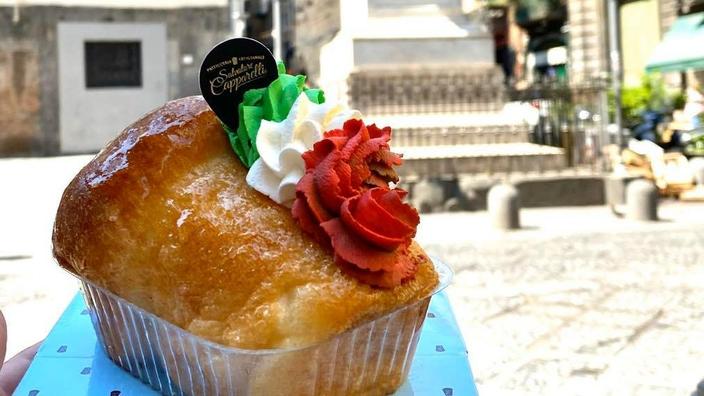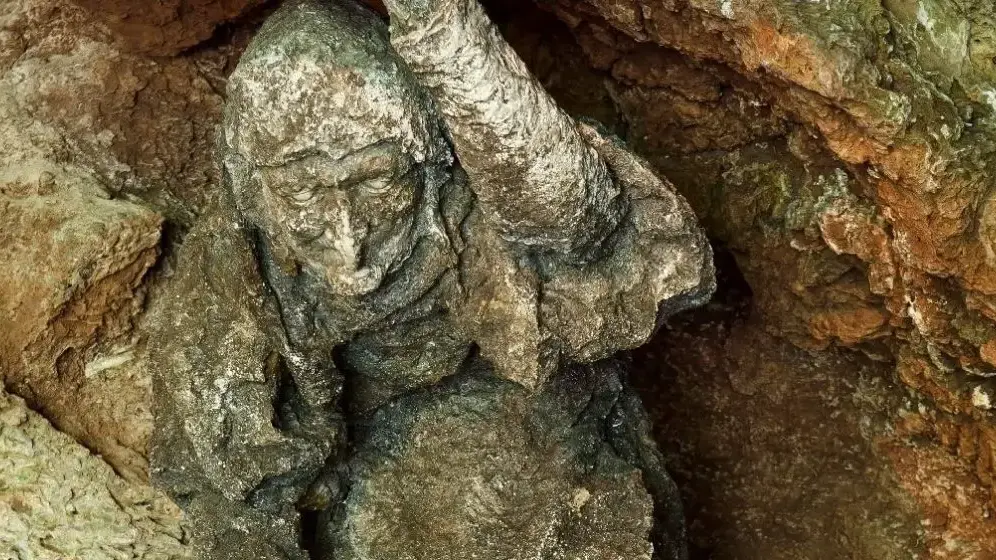“Il babà è una cosa seria”
: baba is a serious thing. It's the name of a song from the 1980s sung by Marisa Laurito and the motto of the Capparelli family, pastry chef from father to son whose shop is located in the historic center of Naples, Via Dei Tribunali. Every day, in the small lab protected by a Christ on the cross that smells of sugar and alcohol, 15 kilos of dough are mixed in a large mixer for an hour. Once the dough (whose beautiful yellow color attests to a remarkable quantity of eggs) has reached the ideal texture, it is left to rest for 5 hours. In Italian, this rest is called “levitazione”, a word which, for a French ear, evokes both the cloudy texture of the baba and the peaks of gourmet pleasure to come. After the rest phase,the son-in-law of Salvatore Capparelli, who sports tattoos and a t-shirt stamped with the name of the house, gathers the dough into a beautiful piece of dough then, with a gesture full of agility, throws it into tall aluminum moulds. The young man learned pastry from his stepfather.
To discover
Partner stay in Italy |
8 days |
Treasures in the Gulf of Naples
Trips to Italy: tailor-made tours, hotels and stays from our partners
Read alsoEscape to Naples, in the footsteps of Paolo Sorrentino
A family matter
As with the Sorbillos, king of pizza since the 1930s, the baba is, in Naples, a family affair, even if, here as elsewhere,
Top Chef
-style programs are beginning to arouse vocations outside of siblings. . After baking, the pretty brioche-shaped cakes are squeezed into rows of onions before being immersed in a bath of hot rum. Salvatore masterfully grabs the perforated containers and plunges them into the alcohol. You could almost hear the babas sigh of relief when they touch the golden-colored liquid and swallow when the dough has absorbed it completely, like a greedy sponge. But not too much is needed! The rum-filled baba must retain its elasticity.
With an expert hand, Salvatore feels each baba to check that it will be able to bounce well in the mouth. He presses them like sponges, and then, miraculously, the wrung baba returns to its original shape, like an anti-stress ball.
“For us the 'masticazzione' is important”
, he insists. In fact, Italian cakes are plump, fleshy, creamy. They are made to flatter the taste buds, not like French cakes which are more delicate, underlines the pastry chef. It is true that French pastry evokes less abundance than mastery. In recent years, in France, the new leaders of French pastry have even tended to reduce sugar in favor of fruits and citrus fruits in order to reveal the authentic taste of the ingredients.
Read alsoIn Naples, five artistic and atypical addresses
sugar is king
In Naples, sugar is still king. In the windows, exuberant pastries strut before the eyes of passers-by and gourmets. Cannoli overflowing with ricotta, cabbage of all kinds, stuffed with pastry cream, pistachio, praline or lemon cream, liqueur, candied fruit... Here, all combinations are allowed and are reminiscent of fusions of marble, stucco and painting of churches and palaces. As if Baroque architecture had inspired Neapolitan pastry chefs… Or the other way around! This parallel did not escape the author Dominique Fernandez, who sees in the Neapolitan churches real mounted pieces and in the rockery effects of the San Gregorio Armeno church (where the delicious pastiera, a ricotta pie served at Easter), constructions of caramel.
If you find yourself at one of the famous pastry shops in the historic center, at Scartuchio, Infante or Carraturro, you will come up against the hyperglycemia of tradition. And if you are in the city for a short stay, you might as well succumb! In Naples we have a coffee baba in the morning. It must be said that the alcoholic and spongy sweetness of the cake perfectly counterbalances the bitterness of a good ristretto. Leaning on the counter, lulled by the hubbub of the percolator and the conversations, one has the impression that the baba is as old as the mermaid Parthenope, mythical founder of the city, yet he settled relatively late on the displays of the cafeterias.
Many Neapolitan pastries (and there are many of them) have their origins in the pagan or Christian liturgy, such as Struffoli, this mound of honeyed balls that we eat at Christmas and which dates back to ancient Greece or, better known, the sfogliatella, another Neapolitan star.
A delicacy of puff pastry stuffed with ricotta whose motherhood we owe to the nuns of the monastery of Santa Rosa in Amalfi.
Read alsoGourmet getaway to Italy, discovering the “white gold” of Gragnano
A divine sin
The baba at Capparelli no longer has to prove himself.
Facebook / Pasticceria Capparelli
By comparison, the baba is decidedly profane. Moreover, he arrived by the royal road, following a few interesting detours. It was in the 18th century that the famous pastry chef Stohrer, then in the service of the Polish king Stanislas Leszczynski living in Nancy, had the idea of soaking a slightly dry kouglof in Malaga wine enhanced with saffron. The monarch was instantly won over and Stohrer was so talented that when Marie Leszczynska, Stanislas' daughter, married King Louis XV in 1725, she took him to Versailles. From there, the baba follows his irresistible ascent. He seduced the older sister of Marie-Antoinette, married to the King of Naples Ferdinand I, who, impressed by the splendor of Versailles, brought French recipes and cooks back to her table.The baba quickly became the fashionable dessert in the meals of the high aristocracy of the Kingdom of the two Sicilies, but it was only later, at the time of the unification of Italy in the 19th century, that it became popular and begins to populate the windows of pastries and cafeterias with its round head and chubby body.
As for the baba at Capparelli, he no longer has to prove himself.
It's fluffy but not soft because the dough has rested enough and the rum used isn't too strong, just tasty.
This is how the house has imposed itself alongside its colleagues and competitors for decades.
Thus, at the Capparelli's, we do not trifle with tradition.
And innovation in all this?
How to create in a city where custom is so strong and in a neighborhood where competition is so fierce?
Of course there is baba with cream or Limoncello, but the Capparellis went further, they created Aurora.
Imagine a pretty sfogliatella sprinkled with a powder of icing sugar.
As you prepare to bite into a flaky delight, you encounter the softness of
Read alsoFlorence to eat and drink: our 5 addresses for a
gourmet
aperitivo
The three best babas in Naples
Capparelli
Impossible to miss Capparelli which occupies a whole section of the Via dei tribunali.
On one side, a café where you can drink a ristretto, on the other the shop where you can buy the marvelous babas, the classic is at €1.50, the giant at €2, the cream one at €2.50 and the Aurora at €3.
327 Via dei Tribunali.
Phone.
: +39 081 454310.
cute
Located in Piazza Cavour a few steps from the National Archaeological Museum, Mignone is a neighborhood institution and is always full.
You will find several variations of babas, with pastry cream, whipped cream, topped with strawberries or pistachios.
Maximum temptation and very affordable prices (around €2).
145 piazza Cavour.
Phone.
: +39 081 293074.
Attanasio
To tell you the truth, at Attanasio, it is above all the Sfogliatella the specialty.
But the Baba is also very serious.
If you arrive in Naples by train or go to Pompeii for the day, stop by the shop which is a stone's throw from the station.
Vico Ferrovia 1/2/3/4.
Phone.
: +39 081 285675.















